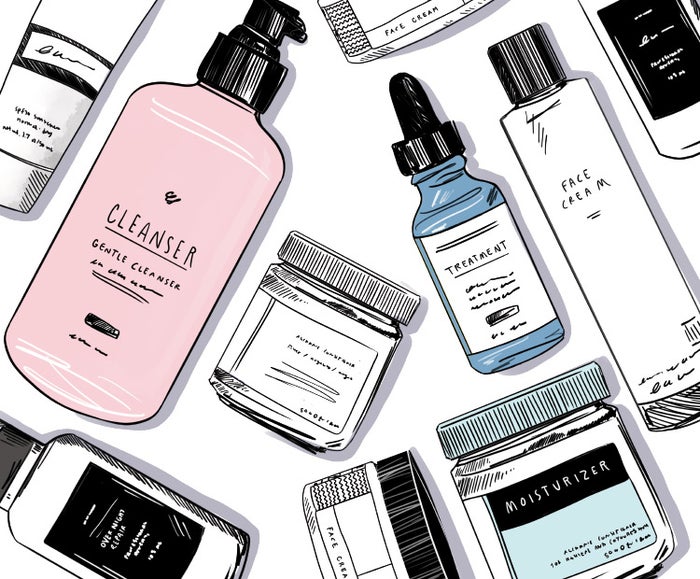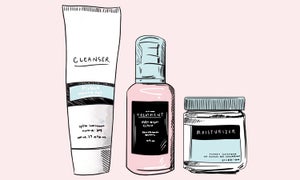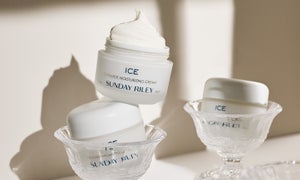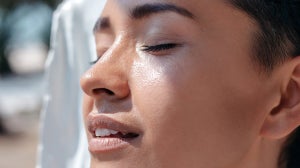

As you layer your holy grail toners, serums and moisturizers, have you stopped to consider how well their ingredients actually play with each other? It’s almost impossible to go wrong with OGs like retinol and vitamin C, but it’s a different story once they’re all mingling in your skin. The fact is that even A-list ingredients that are known to be powerhouses on their own can be a downer for your skin when mixed and matched the wrong way.
Like your favorite snack combos, some skincare ingredients are just better together. But there are other ingredients that should be kept far away from each other as using them at the same time could either cancel out their benefits, or worse, cause irritation. “You want ingredients that will mix and not separate like oil and water in order to get an even distribution of the mixture on your skin. Mixing ingredients can provide additive effects to your skin,” explains Dr. Deborah Yu, a cosmetic surgeon with The Plastic Surgery Center. “If ingredients do not necessarily ‘match,’ you should be aware that you could have a less than optimal result.”
So, before you concoct your perfect skincare cocktail, here’s a breakdown of the best skincare ingredients that work well together and which pairings you need to split up.
Table of Contents:
- Understanding Ingredient Synergy
- Hydration and Moisture Boosters
- Brightening and Even Tone
- Anti-Aging Powerhouses
- Skincare Ingredients Not to Mix
- Customizing Your Skincare Routine
- The Bottom Line
Understanding Ingredient Synergy
True ingredient synergy in skincare extends beyond having compatible actives—it’s about making sure they all have each other’s backs. Synergy in your skincare routine means curating a lineup of potent ingredients that build on each other’s strengths, enhancing and balancing their properties, to create a whole that’s greater than the summary of its parts. In short, it allows you to achieve results that are even better than the combined effects of using them individually. Choosing synergistic ingredients is especially important when you’re trying to address specific concerns as the right combinations can deliver even more targeted results.
Hydration and Moisture Boosters
Looking to transform dry and dull skin? These pairings are matches made in hydration heaven.
Hyaluronic Acid with Glycerin
Together, these humectants provide parched skin with intense hydration from all sources, resulting in an instantly plump and glowing complexion. Hyaluronic acid draws water from the air and helps the skin retain water. Meanwhile, glycerin amps things up by attracting moisture not just from outside but by also pulling water from your skin’s deeper levels into the surface layers.
Ceramides with Niacinamide
Ceramides and niacinamide are skincare BFFs that play a crucial role in strengthening and maintaining your skin’s natural barrier, and in doing so, they help the skin hold and retain moisture more effectively, resulting in a healthier, hydrated complexion and more even tone and texture. But what truly makes niacinamide the ultimate bestie is the fact that it also happens to support and help promote the skin’s natural production of ceramides.
Hydrating Oils with Humectants
Humectants are water-loving substances that attract and hold moisture in the skin, while hydrating oils are natural oils that lubricate and moisturize the skin. And yes, you heard that right. Oil and water. It’s a head-scratcher, for sure, but allow us to explain. Humectants draw water into the outer layer of the skin, and because they’re not oil-soluble, applying an oil after can help lock all that moisture in, preventing water-loss on the surface and allowing the hydrating effects to last longer.
Brightening and Even Tone
For a clearer and more even skin tone and texture, try these complexion-brightening combos.
Vitamin C and Vitamin E
Vitamins C and E are antioxidant superstars that are absolute staples regardless of your skin concern. They encourage collage production and stem the damage caused by free radicals and oxidative stress, delaying signs of premature skin aging like sagging, hyperpigmentation and uneven texture. Not only that, they’ve also been found to be effective in fending off sun damage, especially in the same formula and paired with sunscreen. The best part? Research shows that vitamin E, together with ferulic acid, can also help in stabilizing vitamin C and prevent it from degrading.
Alpha Hydroxy Acids (AHAs) with Beta Hydroxy Acids (BHAs)
BHAs work by going deep into the skin’s layer to break down and dissolve pore-clogging skin cells and excess oils while AHAs exfoliate the skin’s surface by sloughing away dirt and debris, allowing BHAs to be absorbed and do their job more effectively. But it’s not without a catch. Layering AHAs and BHAs separately can be too much for your skin and lead to dryness and irritation. The best way to reap their enhanced benefits is to find a single formula that takes advantage of their complexion-clearing properties at the same time.
Licorice Extract with Arbutin
Licorice extract and arbutin act as tyrosinase inhibitors because of their anti-pigmentation properties. Tyrosinase is the process of converting tyrosine into melanin, which, in turn, gives the skin its color. Together, they regulate your skin’s melanin levels and prevent overproduction that leads to discoloration. When it comes to existing dark spots, licorice steps in by dispersing the melanin while arbutin slows down its production that eventually fades hyperpigmentation and hinders the formation of new dark spots.
Anti-Aging Powerhouses
These are the wrinkle-fighting warriors you need to keep fine lines, sagging and photodamage at bay.
Retinol and Peptides
When it comes to anti-aging ingredients, retinol is hands-down the champ. But that super potency comes with the potential to irritate and dry out your complexion especially during your skin’s adjustment phase. That’s where peptides come in. These amino acid chains perform important tasks for your skin, including firming and tightening, smoothing fine lines and strengthening its barrier. They also make great companions for retinol as their soothing properties balance out and alleviate retinol’s harshness while complementing its anti-aging functions.
Coenzyme Q10 with Vitamin B3
Vitamin B3, commonly known as niacinamide, is a hardworking ingredient that meshes well with plenty of top-tier actives like the anti-aging star CoenzymeQ10 (CoQ10) or ubiquinone. Research shows niacinamide’s barrier-repairing, collagen-boosting and anti-inflammatory abilities work in tandem with CoQ10’s antioxidant and cellular functions. This anti-aging twosome improves the overall effectiveness of formulas containing both ingredients, allowing your skin to reap the maximum benefits of their exhaustive skin-enhancing strategy.
Antioxidants with SPF
There’s no such thing as too much sun protection. The more protected your skin is from photodamage, the better chances you have of maintaining youthful-looking skin as you age. But even when you slather sunscreen daily, harmful UV rays still make it to your skin—especially when you forget to reapply—which can then cause free radical damage. Antioxidants act as the perfect backup to your sunscreen: They boost your SPF’s UV-fighting properties while neutralizing free radicals from the harmful rays that slip through.
Skincare Ingredients Not to Mix
Sometimes, two good things don’t necessarily lead to something greater. Skincare layering can backfire and make products less effective. So, what skincare ingredients shouldn’t be mixed? Here are the unhappy couples.
Benzoyl Peroxide and Retinoids
When your skin is battling breakouts, you’re going to want benzoyl peroxide and retinoids like tretinoin in your corner. Just not together and definitely not at the same time. “They have not been typically used together benzoyl peroxide may reduce the effectiveness of tretinoin,” explains Dr. Yu. When adding both to your routine, only apply benzoyl peroxide during the day and keep retinol for nighttime use.
Vitamin C and AHAs/BHAs
Another combo you need to be wary of because of how one can inactivate the other is vitamin C and AHAs/BHAs. According to dermatologist Tsippora Shainhouse, MD, FAAD, “Some acids can change the pH of the vitamin C and destabilize it, potentially rendering it inactive.” To get the exfoliating benefits of AHAs/BHAs without letting go of vitamin C’s antioxidant action, stick to a schedule: use vitamin C in the morning and your acid-based treatments at night.
Retinoids and AHAs/BHAs
Due to their high potency, retinoids can cause reactions and irritations for some skin types. This is especially true for first time users, so using products with AHAs/BHAs with them is only going to make matters worse. Chemical exfoliators will further tick off skin that’s already feeling sensitive from retinoid use, leading to redness, itchiness, flaking and dryness.
Salicylic Acid and Benzoyl Peroxide
Doubling up on your acne treatment with salicylic acid and benzoyl peroxide isn’t the game-changer you think it could be. Salicylic acid can trigger dryness and irritation in some skin types, which can be exacerbated by using an antiseptic like benzoyl peroxide. These two should never be used to treat the same area of skin, even at different times of the day. Instead, use a salicylic acid face wash as your go-to breakout-prevention product and only apply benzoyl peroxide (without salicylic acid) as a spot treatment for when a pimple does pop up.
Benzoyl Peroxide and Vitamin C
These two ingredients don’t get along, so strike them out of your potential combos. Benzoyl peroxide can oxidize vitamin C and make it less effective, so just like with salicylic acid, this duo isn’t meant to mingle. If you must have both in your routine, stick to a mornings-only rule for vitamin C and benzoyl peroxide in the evening.
Salicylic Acid and BHAs/AHAs
We know we said AHAs and BHAs are good together, so why is salicylic acid—one of the most widely used BHAs—in the no-go list? Let’s clear up the confusion. When used in the same formulation, AHAs and BHAs work hand in hand to prevent clogged pores, slough away dead skin cells and balance oil production. But it’s a different story when you layer and use them separately, which can increase the likelihood of over-exfoliation, dryness and irritation.
Customizing Your Skincare Routine
When it comes to pairing ingredients and adding new combos to your skincare routine, balance and timing are everything. Here are some tips to consider before you embark on your skincare layering journey.
- Read the product labels. It’s the quickest way to make sure you’re using synergistic components and not just slathering a hyped-up formula with trendy ingredients that don’t necessarily complement each other.
- Layer your products accordingly. Some ingredients can only do their magic when applied in a certain way. Lighter, water-soluble ingredients like hyaluronic acid should go before heavier emollients and face oils.
- Consider when to apply certain ingredients. Retinol is best used in the evenings, especially if you’re using it with other potentially irritating ingredients. The same rule applies for vitamin C when used with acne treatments and like benzoyl peroxide and AHAs/BHAs.
- Certain ingredients work best when used in the same formula. Vitamins C and E are both antioxidant royalties, even on their own. But together in the same serum? They’re the closest you’ll get to finding the fountain of youth.
- Before anything else, do a patch test. Apply a small amount of the new product on a discreet area of your skin and observe for signs of sensitivity or irritation.
- Talk to an expert. Always consult a medical professional if you’re unsure about the ingredients in your skin care products.
The Bottom Line
In most cases, it takes more than the power of a single ingredient to transform the look and feel of your skin. The best results can be achieved with ingredients that work synergistically. These dynamic duos don’t just deliver the same benefits: They go beyond the combined effects of using ingredients individually, and instead, enhance, support and balance each other’s functions and properties. So, while you can’t mix and match active ingredients with abandon, there are plenty of proven skincare ingredients that work well together—and your skin’s soulmates are just waiting to be discovered. All it takes is a little experimentation and paying closer attention to skincare ingredients that should and shouldn’t be mixed.
Ready to find the ultimate pairings for brighter, healthier and more youthful-looking skin? Here’s a list of all the superstar ingredients you can find on Dermstore.

With over 10 years of writing and editing experience, Janeca Racho has worked with clients in the fashion, entertainment, food, health and travel industries. An adventurer at heart, she will gladly trade her heels for a good pair of hiking shoes and skip hotels to camp under the stars. She loves horror movies, googling ingredients in her beauty products and backpacking trips with her toddler. Her newfound obsession: nude lipstick.
Related Articles






